Elaborate golden treasures with traces of cannabis and opium have been discovered in a secret chamber hidden in an ancient Scythian burial mound near Strovopol, Russia. Described as a once-in-a-century discovery, the golden artifacts and drugs may point to ancient rituals and wars as chronicled by Greek historian Herodotus.
The Scythian kurgan, or burial mound, was uncovered during power-line development in the Caucasus Mountains of southern Russia in 2013. Dubbed Sengileevskoe-2 by archaeologists called in to excavate the mound, it was found the site had at one time been looted and not much was presumed to lie within.
However, archaeologist Andrei Belinski and his team discovered what looters had not — a thick layer of clay in the ground hiding a rectangular chamber. Inside the hidden chamber lined with broad, flat stones was a golden treasure dating back 2,400 years. The discovery of the buried hoard beneath the kurgan remained secret until excavations could be completed.
The incredible finds “are shedding light on the shadowy world of the Scythians, fierce nomads whose exploits—and drug-fueled rituals—were chronicled by the Greek historian Herodotus,” an article from National Geographic reports.
Anton Gass, archaeologist at the Prussian Cultural Heritage Foundation in Berlin tells National Geographic, “It's a once-in-a-century discovery. These are among the finest objects we know from the region.”
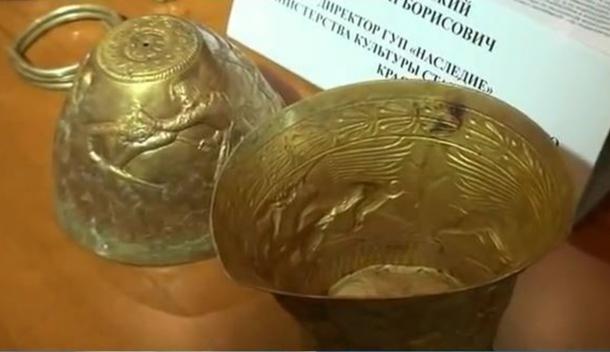 Golden vessels and bracelet discovered by archaeologists in a kurgan near Strovopol in 2013. Image via Video F20S
Golden vessels and bracelet discovered by archaeologists in a kurgan near Strovopol in 2013. Image via Video F20S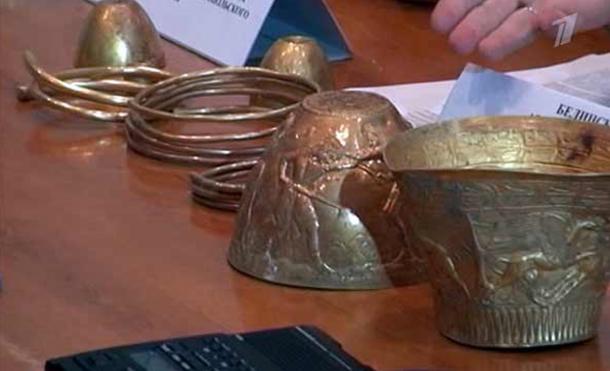
The artifacts revealed evidence of ancient ritual drug use. Image via Video F20S
Archaeologists found seven pounds worth of solid gold objects including: two bucket- or vase-shaped vessels, rings, neck rings, a bracelet, and three gold cups.
- * Reconstruction of Golden Woman, the ancient Scythian Princess of Kazakhstan
- * Long Hidden Scythian Treasure Site Located at Ceremonial Spring in Poland
Criminologists analyzed a black residue found on the inside of the gold vessels. Results confirmed opium and cannabis, suggesting to the researchers that the Scythians had used the plants and vessels in a drug-fueled ritual, as originally reported by Herodotus. He claimed that the Scythians made an intoxicating smoke with a plant, “that no Grecian vapour-bath can surpass … transported by the vapor, [they] shout aloud.”
National Geographic writes, “Because the sticky residue was found on the inside of the vessels, Belinski and Gass think they were used to brew and drink a strong opium concoction, while cannabis was burning nearby. ‘That both drugs were being used simultaneously is beyond doubt,’ Gass says.”
As reported by Russian news site 1TV, the vessels are thought to have been created for members of royalty. They are decorated with highly-detailed and dramatic scenes. Animals and humans are depicted fighting and dying. The images have been so intricately wrought that details such as weapons, garments and lifelike haircuts can be easily seen.
One vessel depicts a ferocious bearded man killing young warriors. Another features mythical Griffons tearing apart a stag and horse in gruesome detail. Belinski believes the powerful and graphic images represent the Scythian underworld.
Belinksi tells National Geographic, “I’ve never seen such a detailed representation of the clothing and weaponry of the Scythians. It's so detailed you can see how the clothing was sewn.”
One image significant to the researchers is the scene of the fierce, older, bearded man slaying the young man. Gass thinks this may illustrate the “Bastard Wars” as chronicled by Herodotus. The Greek historian wrote that after a war against the Persians lasting 28 years, the Scythians returned home to find a generation of young men living in their lands — the supposed ‘bastard children’ of the Scythian wives and their slaves. Herodotus wrote that the youths were all slaughtered as intruders.
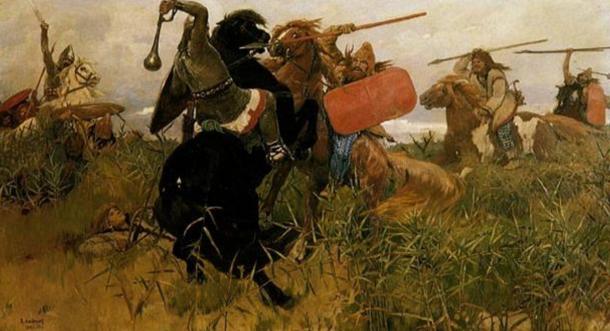
Battle between the Scythians and the Slavs (Viktor Vasnetsov, 1881). Public Domain
However, Belinski favors the idea that the representation depicted on the vessel of mass killing is metaphorical. It may be imagery representing the discord and power imbalance after the death of a king. These items were, after all, discovered in a burial mound of a presumed high-status individual.
Belinski says, “When a king died, there was chaos. The spirit world was upset by the death of the king, and order had to be born anew.”
- * The Royal Kurgan of Kerch: The burial mound built by a king
- * Tattooed Scythian Warriors, Descendants of the Amazons? Part One
The Scythians were a nomadic people of Iranian descent who migrated from central Asia into southern Russia and Eastern Europe. They founded a powerful empire in the region of what is now Crimea, and were well known for their skills in battle and their horsemanship. No Scythian cities or settlements remain, but their burial kurgans can be found from Mongolia to the Black Sea. The Scythians were known for their ferocity in battle, but while the nomads did fight and loot, they also established and secured control of trade routes via diplomacy and good relations with local populations. The steppes art typical of the Scythians was intricate and decorative. Motifs were often very detailed animal and human figures.
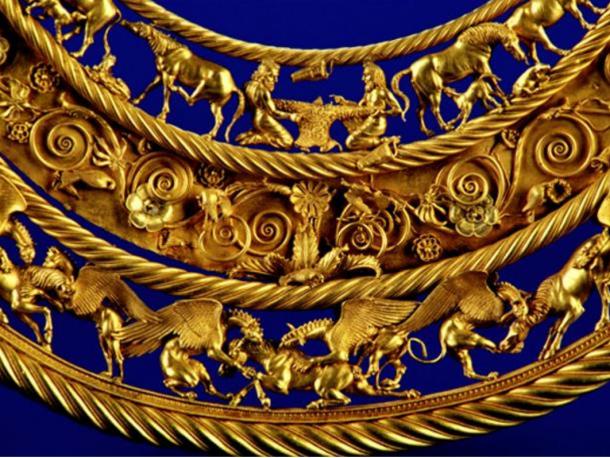
Gold Scythian pectoral, or neckpiece, from a royal kurgan in Tolstaya Mogila, Ordzhonikidze, Ukraine, dated to the second half of the 4th century BC. The central lower tier shows three horses, each being torn apart by two griffins. Representational image. Wikimedia Commons
Elaborate hoards of goods have been found at burial mounds and ceremonial sites across Central Asia, southern Russia and Europe, but the newly discovered treasure near Strovopol has historians and researchers reexamining the ancient stories of the Scythians.
Excavations of the kurgan were completed last fall, but a network of earthen rings and trenches were found that researchers believe might be part of an expansive ceremonial complex. The project is on hold due to political tensions in the region, but archaeologists hope to continue digging soon, to discover more hidden secrets beneath the ancient Scythian mound.
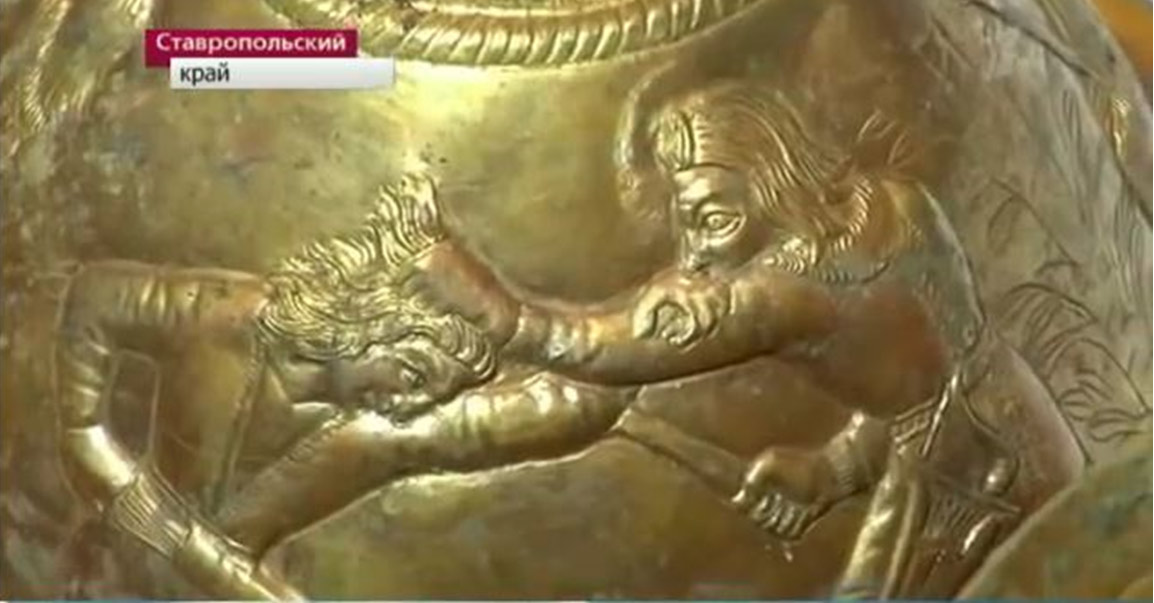
No comments:
Post a Comment